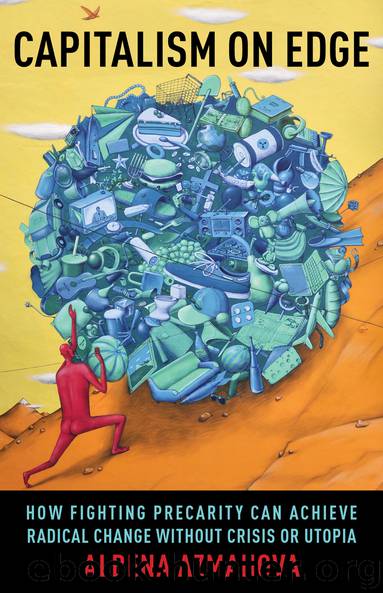Capitalism on Edge by Albena Azmanova;

Author:Albena Azmanova; [Неизв.]
Language: eng
Format: epub
Publisher: Lightning Source Inc. (Tier 3)
6
WHAT IS AILING THE 99 PERCENT?
I must study politics and war, that our sons may have liberty to study mathematics and philosophy. Our sons ought to study mathematics and philosophy, geography, natural history and naval architecture, navigation, commerce and agriculture in order to give their children a right to study painting, poetry, music, architecture, statuary, tapestry and porcelain.
—John Adams, in a letter to Abigail Adams, 1780
We have established that the contemporary context is void of utopia, revolution, and even a life-threatening crisis of capitalism. The potential for overcoming capitalism should be sought elsewhere. Unlike in previous historical junctures, the current emancipatory opening is triggered neither by troubles in capitalism’s economic performance (as during the Great Depression of the 1930s) nor by indignation at its poor distributive outcomes (impoverishment, inequality, and exploitation engendering class war, as during the mid-nineteenth-century upsurge of socialism). I will argue, in what follows, that a countermovement against capitalism is now being generated by another phenomenon: namely, that a multiplicity of social groups across the capital–labor divide, irrespective of how they are affected by the distribution of social advantage and wealth, are aggrieved by capitalism’s very constitutive dynamic—the competitive production of profit—even as productivity and economic growth are rising.
Let me begin from where we happen to be historically—a time of vocal social protests. The outrage against inequality (“tax the rich”), the demonization of greedy bankers (as if they would be doing their job if not trying to maximize profit), the protests against austerity (implying an entitlement to affluence), the calls for exclusion of immigrants (as these “desperate people” menace the social peace) all signal, in various ways, a longing for the “roaring nineties,” before the financial meltdown of 2007–2008, before the sense of physical insecurity unleashed by 9/11, before the migration “crisis” of 2015. Yet this was a time when neoliberal capitalism was preparing the economic and social disasters of the early twenty-first century, intensifying the drive for competitive profit production at the expense of human beings and nature.
Left-wing political forces are now mobilizing for the recovery of democracy by way of radical equality, hoping for the return of the inclusive prosperity that existed under welfare capitalism, which neoliberal capitalism all but eradicated. The Party of the European Socialists (the center-left group of the European Parliament) built its platform for the May 2019 elections on “Eight Resolutions for Equal Society” in a nostalgic gesture to the welfare state. However, it was this inclusive prosperity—based on enhanced consumerism—that drove production and job creation, which wrecked the environment.
Much present-day social protest and political mobilization is defensive, nostalgic, or conservative in nature; some of it is even reactionary. Yet, as per the formula of critique I elaborated in chapter 2, it all supplies valid points of entry into the larger story of social injustice, points from which the search is to commence for the origin of these grievances in the structural contradictions and constitutive dynamics of capitalism. I proposed that normative critique and strategies of emancipation should emerge from an
Download
This site does not store any files on its server. We only index and link to content provided by other sites. Please contact the content providers to delete copyright contents if any and email us, we'll remove relevant links or contents immediately.
The Secret History by Donna Tartt(18860)
The Social Justice Warrior Handbook by Lisa De Pasquale(12143)
Thirteen Reasons Why by Jay Asher(8800)
This Is How You Lose Her by Junot Diaz(6802)
Weapons of Math Destruction by Cathy O'Neil(6152)
Zero to One by Peter Thiel(5692)
Beartown by Fredrik Backman(5609)
The Myth of the Strong Leader by Archie Brown(5429)
The Fire Next Time by James Baldwin(5253)
How Democracies Die by Steven Levitsky & Daniel Ziblatt(5133)
Promise Me, Dad by Joe Biden(5089)
Stone's Rules by Roger Stone(5028)
A Higher Loyalty: Truth, Lies, and Leadership by James Comey(4851)
100 Deadly Skills by Clint Emerson(4845)
Rise and Kill First by Ronen Bergman(4705)
Secrecy World by Jake Bernstein(4652)
The David Icke Guide to the Global Conspiracy (and how to end it) by David Icke(4629)
The Farm by Tom Rob Smith(4442)
The Doomsday Machine by Daniel Ellsberg(4420)
